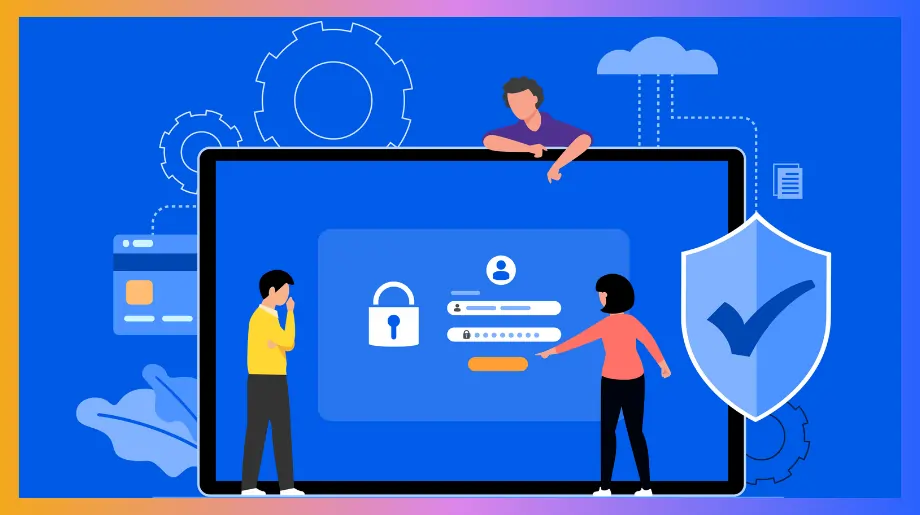Your workers get locked out of work apps daily. With over 20+ logins to remember, they forget passwords, reuse weak ones, or flood your IT team with reset requests.
That’s where Session-based and Token-based authentication come in.
Both aim to keep your systems secure and your users connected—but they take fundamentally different approaches. One stores credentials on the server. The other hands users a portable, signed token.
So, which one is better for your business?
In this guide, we’ll break down how each method works, where they shine, and where they fall short—so you can choose the right approach for your app’s architecture, scale, and security needs.
Session vs Token-Based Authentication: A Detailed Comparison
What is Session-Based Authentication?
Session based authentication is a server-side method that tracks user login state. The server creates session files to store user data after login. You get a unique session ID that links to your saved info on the server.
Here's how the session authentication process works.
- User Login. You send login details through the form to the server.
- Credential Verification. Server checks login details against user database records. If login details match, the server creates a new session.
- Session Creation. The server makes a session file with a unique session ID number.
- Session Storage. Session data saves server-side in memory or database.
- Session ID Distribution. Server sends session ID as HTTP cookie.
- Request Authentication. Browser adds session ID in all HTTP requests.
- Session Termination. Server deletes sessions when logout or time expires.
Advantages of Session-Based Authentication
Session-based authentication offers several compelling benefits for modern applications. These advantages make it an attractive choice for many businesses today.
Your company gets proven security features that work right out of the box. Session systems provide complete control over user access and data protection.
Here are the key benefits that make sessions valuable for your business.
- Immediate Session Control. Your admins can kill sessions right away. This gives your team real-time control over user access. You can block threats instantly.
- Simplified Implementation. Your traditional web apps find session management easy. Most frameworks your developers use support this method well.
- Enhanced Security Features. Sessions give your business advanced security like session limits. You get detailed monitoring and audit trails. Server storage protects your data against tampering.
- Robust State Management. Sessions handle your complex user data well. They work great for your shopping carts. Your multi-step processes become simple.
- Mature Ecosystem. Session authentication has decades of proven development. Your team gets battle-tested code across programming languages. All frameworks support sessions for your projects.
What is Token-Based Authentication?
Token based authentication checks who your users are without storing data on your server. Your system makes special digital passes called tokens. These tokens save on user devices and hold all user info. You get faster apps and better security.
This method puts user data inside the token. Your server does not remember logged-in users. The token saves on the user device and carries everything your system needs. This makes your apps work faster and grow easier.
Here's how token authorization works for your business.
- Authentication Request. Your user types login details into your app.
- Credential Validation. Your server checks if the login details are correct.
- Token Generation. Your server makes a special digital token with user info.
- Token Issuance. Your server gives the token to your user's device.
- Request Authorization. Your user's device sends the token with every request.
- Token Validation. Your server checks if the token is real and valid.
- Access Decision. Your server gives access based on what the token says.
Advantages of Token-Based Authentication
Token-based authentication offers numerous advantages that align well with modern application architectures. These benefits solve real problems your business faces every day.
Your company gets better performance, stronger security, and easier scaling. Token systems work great for distributed teams and mobile users.
Here are the key benefits that make tokens perfect for your growing business.
- Stateless Architecture. Tokens remove the need for server-side session storage. Your apps can scale without session problems slowing you down.
- Cross-Domain Compatibility. Tokens work across different domains and subdomains. Your distributed systems and microservices connect without cookie headaches.
- Mobile-First Design. Tokens work great with mobile apps and single-page applications. Cookie management becomes simple for your development team.
- Performance Benefits. Token systems skip database lookups for session checks. Your apps run faster under heavy user loads.
- Microservices Integration. Tokens help your microservices talk to each other. Each service checks user access without central session storage.
Session vs Token-Based Authentication: A Detailed Comparison
You must pick between sessions and tokens for your business. Each method works in its own way. Your choice affects your company's growth. Smart leaders pick based on real needs.
Let's examine key aspects where session vs token based authentication methods diverge significantly.
Mechanism
Your auth method decides how users prove their identity to your system. This choice affects your app speed and development costs. Wrong picks create slow apps that frustrate your customers daily.
Session Method Works This Way:
- Your server creates files to store each user's login data and session information.
- Users get simple ID numbers that connect them to their stored server data.
- Your server does all checking work when users make requests to your system.
- Server memory holds everything users need while they stay logged into your app.
Token Method Works This Way:
- Your token carries all user info inside itself without needing server storage space.
- No server storage gets used for keeping track of logged-in user information.
- Each user request brings its own proof of identity built into the token.
- Tokens work alone without asking your server for help or extra data lookups.
Key Gap: Sessions need server checks every time. Tokens check themselves fast.
Security
Security protects your business money and customer trust from hackers. Bad security costs you millions in breaches and lawsuits. You need methods that keep your data safe from attacks.
Session Security Features:
- Your admin team can kill any user session right away from the server.
- All important user data stays protected on your own secure company servers.
- CSRF attacks can target session cookies but you can add protection layers.
- Server control gives your security team complete power over user access rights.
Token Security Features:
- Digital signatures stop hackers from changing tokens or stealing user access data.
- No server state means fewer places for hackers to attack your system.
- Stolen tokens stay active until they expire but cannot get changed by attackers.
- Strong crypto math protects all token data from being read by bad actors.
Key Gap: Sessions give instant control. Tokens give crypto protection power.
Stateful vs Stateless
State management affects how your app remembers user actions between requests. This impacts your server costs and user experience quality. Bad state handling creates confused users and high server bills.
Stateful Session Approach:
- Your server remembers every logged-in user and their current app state information.
- Complex user tracking and shopping carts become easy to build and manage.
- Multi-server setups need special systems to share session data between all servers.
- Rich user experiences work well when servers remember what users were doing.
Stateless Token Approach:
- Each user request carries all needed info without server memory being used.
- Your server forgets past user actions which makes growing your system simple.
- Growing becomes easy without complex state management systems eating server resources and money.
- Less server memory gets used because tokens handle their own user data.
Key Gap: Sessions create rich experiences. Tokens make growing your business simple.
Flexibility and Scalability
Your system must handle more users as your business grows bigger. Growing companies need systems that expand without breaking or slowing down. Bad scaling choices limit how big your company can become.
Session Growing Method:
- Multiple servers need shared storage systems like Redis to work together properly.
- You need sticky sessions or database systems to keep user data working.
- Single-server apps handle sessions easily but cannot grow past one machine limit.
- Complex setup gets required when your user base grows beyond a single server.
Token Growing Method:
- Stateless design lets unlimited servers handle users without sharing data between them.
- Load balancers work without session problems that create user login issues daily.
- Cloud systems love token methods because they scale without complex storage sharing.
- Simple setup works for distributed apps that need to handle millions of users.
Key Gap: Sessions need complex sharing systems. Tokens grow without storage limits.
Token Validation
Validation speed decides how fast your app responds to user requests. Slow validation makes users wait and leave your app forever. Fast validation keeps customers happy and engaged with your business.
Session Validation Process:
- Your server looks up user data from storage systems every single request.
- Database queries happen on each request which adds delay to user experience.
- Real-time session control works because server checks happen for every user action.
- Network calls add delay but give you complete control over user access.
Token Validation Process:
- Digital signatures check token validity without calling outside systems for extra data.
- Self-contained tokens let distributed servers check users without asking other systems.
- Token blacklists add complexity when you need to block specific users right away.
- Local server checking works fast because no network delays slow down the process.
Key Gap: Session lookups add delay. Token checking happens fast on local servers.
Storage Mechanism
Storage affects your infrastructure costs and system reliability over time. Wrong storage choices create expensive bills and system failures. You need storage that fits your budget and growth plans.
Server-Side Storage Requirements:
- Sessions need Redis databases or memory storage systems running on your servers.
- Multiple servers must share session data which creates complex backup and sync.
- Storage becomes a potential failure point that can crash your entire user system.
- Infrastructure costs grow as more users need more session storage space.
Client-Side Storage Requirements:
- Tokens live in browser storage or mobile apps on user devices only.
- Your server setup stays simple because no session storage gets needed anywhere.
- Client security becomes important because users store their own login tokens now.
- No server storage costs because users handle their own authentication token data.
Key Gap: Sessions need expensive server storage. Tokens use free user device storage.
Multi-Device and Cross-Domain Support
Modern users access apps from phones, computers, and tablets every day. Your auth system must work across all devices and websites. Single sign-on needs cross-domain features that work everywhere users go.
Session Domain Limits:
- Cookie domain rules limit how sessions work across different website addresses.
- Multiple devices need careful session management or users get logged out randomly.
- Complex integration patterns get required when you have multiple company websites.
- Mobile apps struggle with cookie management because phones handle cookies differently.
Token Cross-Domain Benefits:
- Headers work across any domain without restrictions from browser cookie rules.
- Multiple devices can authenticate at the same time without fighting each other.
- Modern app systems benefit because tokens work the same way everywhere.
- No domain restrictions mean your users get seamless access across all platforms.
Key Gap: Sessions limit cross-domain use. Tokens work everywhere without any limits.
Limitations
Every method has problems you must plan for before building. Understanding limits helps you avoid expensive mistakes that cost time and money. Smart companies plan for these issues from day one.
Session Method Problems:
- Distributed growing becomes complex and expensive as your user base gets bigger.
- CSRF attacks target cookie-based systems but you can add protection with effort.
- Mobile apps struggle with cookie management because phones work differently than computers.
- Server memory requirements grow as more users stay logged in to your.
Token Method Problems:
- Large tokens slow network speed and increase your bandwidth costs over time.
- Secure token blocking needs extra systems like blacklists when users get compromised.
- Client-side storage creates new security risks because users control their own tokens.
- Token size limits exist and big tokens can break some older systems.
Key Gap: Session limits affect growing and mobile. Token limits impact speed and blocking.
Session vs Token Based Authentication: Which One Should You Choose?
Your session vs token based authentication decision impacts everything. Choose wrong and your system crashes when you need it most. This mistake happens more often.
Here are the key things that help you pick the best method.
Choose Session-Based Authentication When.
- Old Style Web Apps. Server-side apps with tight frontend-backend connections work great with sessions. Most web frameworks support sessions without extra setup work.
- Fast Session Control. Banking systems need instant session killing for security threats. Your admins can stop user access right away when threats occur.
- Hard State Management. E-commerce sites with shopping carts benefit from sessions most. Your stateful apps handle hard user data better than other ways.
Choose Token-Based Authentication When.
- Split Systems. Microservices architectures need stateless token validation without coordination overhead problems. Your services work alone without session sharing headaches or storage issues.
- Mobile Apps. Mobile platforms struggle with cookie management in native app environments. Tokens provide clean ways across iOS and Android platforms without browser dependency.
- Cross-Domain Needs. Multi-tenant SaaS platforms spanning multiple domains need token capabilities for flexibility. Your service ecosystems connect without domain limits or hard cookie workarounds.
Common Misconceptions Around Session and Token-Based Authentication
Here are the biggest lies that hurt authentication projects in companies.
Misconception 1. Sessions Are Less Safe Than Tokens
- Both methods work safe when you build them right with proper security measures.
- Sessions give instant control but need CSRF protection to stop common attack methods.
- Tokens use crypto protection but stolen tokens stay active until they expire naturally.
- Your coding skills matter more than which method you pick for your business.
Misconception 2. Tokens Are More Scalable
- Sessions scale well with Redis storage systems that handle millions of users easily.
- Large JWT tokens slow your network speed and cost more bandwidth money monthly.
- Your system design and traffic patterns decide which method works faster for users.
- Scalability depends on how you build things, not which authentication method you choose.
Make the Right Call for Your Stack
Sessions give you control but limit growth. Tokens scale fast but need smart blocking systems. Your auth choice decides if customers stay happy or leave forever. Pick wisely because you cannot change easily later.
Why Choose Infisign
Your business needs the best auth solution without trade-offs. Infisign delivers both session control and token flexibility through zero-trust architecture.
- Passwordless JWT Authentication. Users login with biometrics, passkeys, or mobile devices. No passwords to steal or crack.
- Universal SSO with AI Power. One login grants access to all applications. AI assistant handles access requests based on user roles.
- Zero Trust Token Architecture. Every token request gets verified regardless of source. Cryptographic proofs ensure maximum security.
- Multi-Factor Token Generation. Combine biometrics, device passkeys, and contextual factors for adaptive security protection.
- Seamless API Integration. Perfect for developers building modern applications. REST APIs work across any platform or language.
Ready to Transform Your Authentication? Stop choosing between session control and token flexibility. Your business deserves better than basic authentication trade-offs. Contact Infisign Today - Book Your Demo!
FAQs
Is it better to use JWT or sessions?
The choice between JWT and sessions depends on your specific app needs. JWT tokens work great in distributed systems, microservices, and mobile apps where stateless authentication helps with scaling. Sessions work better for old-style web apps needing instant user control, hard state management, or single-domain setups. Pick based on your real needs.
Is token-based authentication better?
Token based authentication works great for modern apps. It helps mobile apps and big systems scale easily. Tokens let you use many domains without problems. But sessions can be simpler for basic web apps. Pick tokens if you need flexibility. Pick sessions if you want easy setup.





















